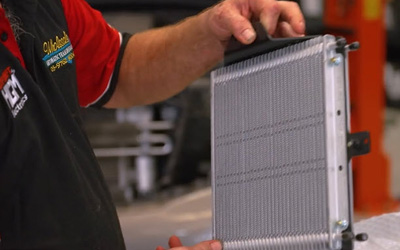Your vehicle’s transmission is one of its most vital components—responsible for transferring engine power to the wheels and enabling smooth gear changes. However, as essential as it is, the transmission is also one of the most heat-sensitive parts of a car. Heat is the enemy of transmission longevity, and excessive temperatures can lead to fluid breakdown, gear slippage, and even total system failure. That’s where a transmission cooler comes into play.
Designed to keep transmission fluid temperatures in check, a transmission cooler is a cost-effective addition that can drastically enhance performance, reliability, and lifespan. Whether you’re driving in extreme heat, towing a trailer, or simply want to extend the life of your vehicle, a transmission cooler can provide tremendous advantages. Below, we break down the top five benefits of installing a transmission cooler and explain why it’s one of the smartest upgrades you can make.
1. Prevents Transmission Overheating
The primary and most important benefit of installing a transmission cooler is temperature control. Your vehicle’s transmission fluid not only lubricates moving parts but also absorbs the heat generated during operation. Under normal conditions, fluid temperatures can range between 80°C and 100°C. However, when driving under strain—such as towing heavy loads, climbing steep grades, or navigating stop-and-go traffic—transmission temperatures can easily soar beyond safe levels.
Overheating is the leading cause of transmission failure. When fluid becomes too hot, it breaks down faster, loses its lubricating properties, and can’t provide adequate cooling. This causes increased friction and wear on internal components. Every 10°C increase in fluid temperature above 100°C cuts the fluid’s life by half, which can result in transmission failure within months if unchecked.
A transmission cooler works by diverting hot transmission fluid away from the transmission housing and running it through a separate cooling unit—typically located in front of the radiator—where it releases excess heat. By maintaining safe operating temperatures, the cooler protects the fluid and, ultimately, the entire transmission system.
2. Extends Transmission Life
Transmissions are expensive to repair or replace. By helping to regulate fluid temperature and preventing overheating, a transmission cooler plays a crucial role in prolonging the life of the transmission.
Cooler, more stable temperatures prevent fluid breakdown and help maintain proper lubrication, allowing internal parts—such as gears, clutches, and bearings—to operate smoothly and without excess wear. This results in less metal-to-metal contact, fewer mechanical failures, and longer intervals between maintenance.
This benefit is especially important for vehicles with automatic transmissions, which are more sensitive to heat than their manual counterparts. Investing in a transmission cooler now can save you thousands in repairs later, making it a highly cost-effective addition.
3. Improves Towing and Heavy-Duty Performance
If you frequently tow trailers, haul heavy loads, or drive in mountainous terrain, your transmission is constantly working harder than average. These driving conditions generate significantly more heat, which puts increased stress on the fluid and internal components.
Installing a transmission cooler is one of the best ways to safeguard your vehicle when it’s under heavy load. It enhances your vehicle’s towing capacity and performance by preventing transmission temperatures from spiking under stress. Many trucks and SUVs designed for towing come with factory-installed coolers for this very reason but these are designed for a worldwide market, not for how vehicles are typically used in Australia. In Australia distances are greater and we tow much more often.
With a transmission cooler, you’ll enjoy smoother shifting, more reliable power delivery, and better long-distance endurance when towing. It also helps reduce the likelihood of slippage or stalling, which can occur when fluid gets too hot.
4. Ensures Consistent and Smooth Gear Shifts
Another often-overlooked benefit of a transmission cooler is its impact on transmission performance and drivability. Automatic transmissions rely on hydraulic pressure, which is managed by the transmission fluid. When fluid becomes too hot, it thins out and loses its ability to hold pressure, which can result in erratic or sluggish gear shifts.
You might experience delayed shifting, harsh gear changes, or slipping between gears—all signs that the fluid is not functioning as intended due to high temperature. This not only affects the comfort of your ride but can also be dangerous in situations where precise throttle and shifting responses are needed.
By keeping the transmission fluid cool and within the optimal viscosity range, a transmission cooler ensures consistent hydraulic pressure, leading to smoother, quicker, and more reliable gear changes. This enhances both performance and safety, particularly in challenging driving environments.
5. Reduces Maintenance Costs and Breakdowns
When your transmission is operating under high stress and temperature, components wear out faster, fluid degrades more quickly, and failures become more frequent. Over time, this leads to increased maintenance costs—more frequent fluid changes, filter replacements, or even repairs due to overheated components.
A transmission cooler acts like a preventative maintenance tool. By keeping fluid temperatures in check, it reduces wear and tear and minimizes the chances of unexpected breakdowns. This means fewer trips to the mechanic, lower maintenance bills, and greater peace of mind on the road.
While a transmission cooler is not a substitute for regular maintenance, it complements your service routine and provides an extra layer of protection that enhances the overall reliability of your vehicle.
Bonus: Who Should Consider a Transmission Cooler?
While any driver can benefit from cooler operating temperatures, a transmission cooler is especially recommended for:
• Towing and Hauling: caravans, trailers, boats, or work equipment.
• Off-Roading: Rough terrain, sand, and steep inclines cause more heat build-up.
• Hot Climates: Desert or tropical regions where ambient temperatures remain high.
• Performance Driving: Sports cars and modified vehicles under high acceleration loads.
• Stop-and-Go Driving: Frequent city driving or long idle periods with minimal airflow.
Conclusion
Installing a transmission cooler is one of the smartest, most affordable upgrades you can make to protect your vehicle. From preventing overheating and extending the life of your transmission, to improving performance under heavy loads, ensuring smooth gear shifts, and reducing long-term maintenance costs, the benefits are substantial.
Whether you’re towing a caravan through the mountains, commuting in a hot city, or just want to protect your investment, a transmission cooler is a reliable line of defense against one of the most common causes of transmission failure: heat.
With the protection and peace of mind it provides, a transmission cooler quickly proves itself as more than just an optional upgrade—it’s a necessity for long-term vehicle health.


